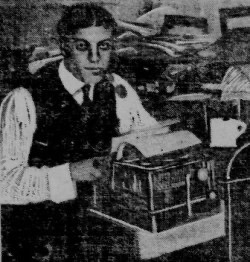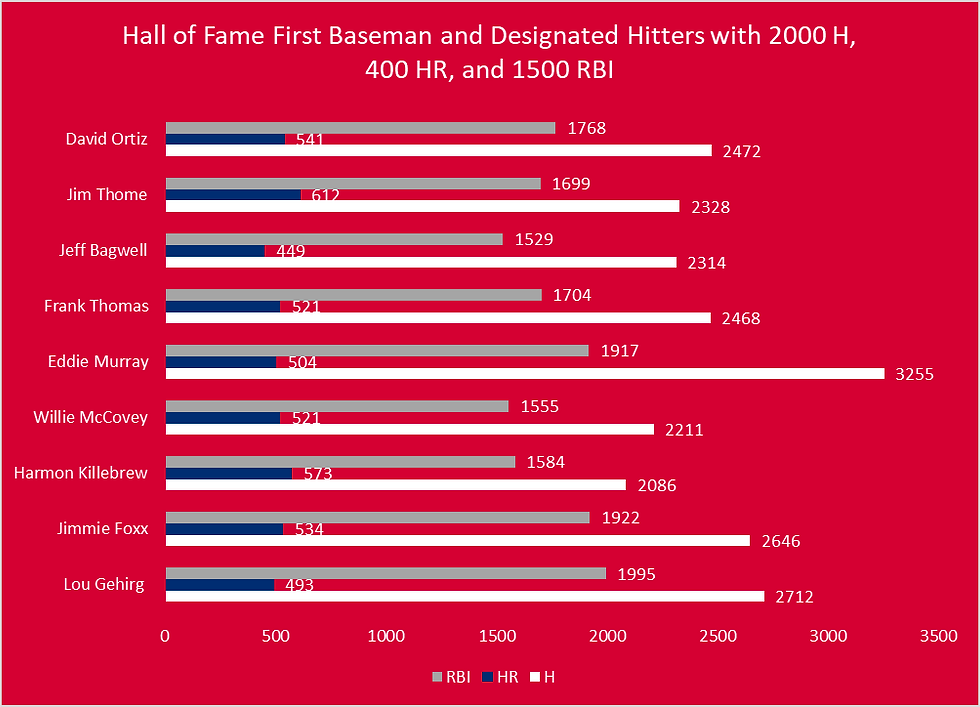Average Numbers for National Baseball Hall of Famers: First Baseman and Designated Hitters
- John Butler

- Mar 25, 2022
- 7 min read
Updated: Mar 30, 2022

Lou Gehrig, pictured left, and Edgar Martínez, right, are arguably the best first baseman and designated hitter ever in the history of the game. Gehrig played in 2,130 consecutive games to produce prolific numbers with amazing consistency while Martínez redefined the position of DH to have the Outstanding Designated Hitter Award named after him in his honor were inducted into Cooperstown in 1939 and 2019. Photos by Rogers Photo Archive/Getty Images and Rod Mar / The Seattle Times.
Jack Butler
First basemen have been known for their power and putting fear into the opposing pitcher throughout baseball’s 153-year history while designated hitters have been doing it for only almost half a century. In the 1920s and 30s, Lou Gehrig was the first deep threat at the position where he led the New York Yankees to 6 World Series Championships over a 12-year stretch. Then, the Detroit Tigers Hank Greenberg arrived and played on those great teams of the 30s and 40s that won the World Series in 1935 and 45, putting up regular season numbers comparable to Gehrig’s. 12 years later, Harmon Killebrew began crushing balls over the fence at Griffith Stadium for the Washington Senators and then became the most prominent slugging first baseman of the 1960s with the Minnesota Twins who were relocated and renamed in 1961 from Washington, D.C.
In the early 60s, the San Francisco Giants’ Willie McCovey put himself on the map as the premiere first baseman, but it wasn’t until 1968 when he was 3rd in the NL MVP and enjoyed 2 more seasons of 30-or-more HR and 100-or-more RBI winning the MVP the next year. At the end of the next decade, Eddie Murray began a career of consistency where he never had a 200 hit season, more than 33 home runs in a season and only had 7 years of 100-or-more RBI but ended up with 3,255 hits, 504 HR and 1,917 RBI to become the 3rd player to have more than 3,000, hits, 500 home runs, and 1,500 RBI. Then, the 1990s saw the emergence of 3 first baseman – Frank Thomas, Jeff Bagwell, and Jim Thome – and a designated hitter – Edgar Martínez – who each had at least 300 home runs, 2,200 hits, and drove in 1,200 runs who combined to average a 150 OPS+. While the 90s sluggers were still producing at high level, David Ortiz was getting started with the Boston Red Sox in 2003 which resulted in 3 World Series titles in a span of 10 years and 7 Silver Sluggers. Once Ortiz retired in 2016, the games best DH was (and still is) Nelson Cruz and during Thome’s dip in production, Miguel Cabrera, Joey Votto, and Freddie Freeman were new young faces at first base.
With an overview of the greatest slugging first baseman and designated hitter from each era in baseball history, now we’ll be analyzing the average numbers needed to reach the Hall of Fame. However, since there are only 3 players whose primary position is designated hitter, the 25 first baseman will be combined with the DHs as their career numbers are alike to avoid presenting inflated data. Also, one addition is made to the 28 total players and added to the designated hitters is Paul Molitor who is enshrined as a third baseman but played more games as a DH and had better statistical seasons as well and the runner up for MVP in 1993 and awarded WS MVP that same year. With that aside let’s begin with WAR and % of games played at 1B/DH.
The average WAR is 60.8 with the highest overall belonging to Lou Gehrig’s 113.7 and highest at designated hitter was Edgar Martinez’s 68.4. Of the 29 players, only 13 reached the mark while the others didn’t and worst WAR by an HOF 1B/DH who played in the MLB unfortunately is Harold Baines’ abysmal 38.7 WAR. Looking at Baines’ numbers, they aren’t that impressive for a 23-year career as he never hit 30 homers in a season while only having three 100 RBI campaigns is what people call a compiler. If Baines is in, then why isn’t Fred McGriff who put up better numbers in four less seasons and only reached to 39.8% on his 10 years on the writers’ ballot. The highest percentage of games played at first was Gehrig whose name was written on the lineup card 2,137 times and Big Papi was penciled at DH for 2,028 games.
Moving to hits, the average is 2,265 where Cap Anson collected the most with 3,455 – 2,614 were singles – and Frank Chance has the fewest by an MLB HOF first baseman with 1,274. Close to half of the Hall of Fame 1B and DHs are in between the 25th to 75th percentile, Eddie Murray and Paul Molitor are in between the 90th and 100th percentile, and Anson is the 100th percentile. The first base/designated hitter combo combined to average 416 doubles which is fourth among the positions behind second baseman, rightfielders, and rightfielders average of 425, 435, and 443 respectively. 62.1% or 18 players reached the two-bagger mark with Anson again leading a hitting category with 582 double which is good for 23rd on the all-time list. From the 29 1B/DHs, the home run average stands at 306 which was met by 16 Hall of Famers with 6 of them in the top 25 on the all-time home run list – 20. Frank Thomas (521), 20. Willie McCovey (521), 19. Jimmie Foxx (541), 17. David Ortiz (541), 12. Harmon Killebrew (573), and 9. Jim Thome (612).
With the prolific power averages on display, there are only 8 Hall of Fame first baseman/designated hitters with more than 2,000 H, 400 HR, and 1,500 RBI. The list includes Lou Gehrig, Jimmie Foxx, Harmon Killebrew, Willie McCovey, Eddie Murray, Frank Thomas, Jeff Bagwell, Jim Thome, and David Ortiz. From the group, the most hits, home runs, and RBI belongs to Murray, Thome and Gehrig with 3,255, 612, and 1,995 respectively.

This graph looks at players who have more than 2,000 hits, 400 home runs, and 1,500 RBI which consists of 7 first baseman and 1 designated hitter who redefined the position during the er that they each played in. Graph by Jack Butler.
Going deeper, just 5 players have more than 3,000 H, 500 HR, and 1,900 RBI which includes Willie Mays, Hank Aaron Eddie, Murray, Álex Rodríguez, and Albert Pujols*. Aaron leads the three stats with 3,771 hits, 755 home runs, and 2297 RBI which rank 3rd, 2nd, and 1st on those all-time lists. Albert Pujols who turned 42 earlier this year in January is considered by many to be the greatest first baseman of the 2000s and if he signs with a team before the season starts, “The Machine” is only 84 home runs and 148 RBI away from moving past Barry Bonds and Aaron for the all-time lead. Whenever Pujols retires he’ll be a no brainer for Cooperstown with 10 consecutive seasons and hitting over .300 with 30 HR, 100 RBI along with 3 NL MVPs and leading the St. Louis Cardinals to two World Series Championships in 2006 and 2011.

Only a short list of players has reached the milestones of 3,000 hits, 500 home runs, and 1900 RBI consisting of Willie Mays, Hank Aaron, Eddie Murray, Álex Rodríguez, and Albert Pujols. If you combined the 5, they would average 3,347 hits, 659 home runs, and 2,071 RBI. Graph by Jack Butler.
First baseman and designated hitters don’t run much in today’s game, but back in the day Cap Anson, George Sisler, Frank Chance, Jake Beckley, and Roger Connor recked havoc on the basepaths all stealing 244 bases or more in their careers. Paul Molitor stole the most bases with 504 even if 71.8% of them were when he primarily played third base. Even more interesting is that Jeff Bagwell known for his power had two 30 home runs and 30 solen base seasons in 1997 and 1999.
Now onto the average slash line, OPS and OPS+ where the 29 1B/DHs averaged a .308/.390/.513 slash line, 902 OPS, and 143 OPS+. Only 8 players reached all five averages – Lou Gehrig, Dan Brouthers, Jimmie Foxx, Hank Greenberg, Buck Leonard, Johnny Mize, Mule Suttles, Edgar Martínez. The OBP, SLG, OPS, and OPS+ marks were met by Frank Thomas, Jeff Bagwell, and Jim Thome while the average OPS and OPS+ was met by just David Ortiz. SLG and OPS+ was reached by Willie McCovey, Cap Anson, Bill Terry, and Ben Taylor exceeded the averages of AVG and OBP, Frank Chance reached the OBP average, and George Sisler, Jake Beckley, Jimmy Bottomley, Roger Connor, and Paul Molitor exceeded the AVG mark.

This graph displays how elite a first baseman/designated hitters were in their careers with 8 of the 22 players reached all five averages from Lou Gehrig to Edgar Martínez means they had an exceptional combination of hitting for average and power. Graph by Jack Butler.
Now that we’ve examined the average numbers for Hall of Fame first baseman and designated hitters, there’s some current great 1B/DHs in today’s game such as Freddie Freeman, Paul Goldschmidt, and Shohei Ohtani along with seasoned veterans Miguel Cabrera, Joey Votto, and Nelson Cruz. The first batch is on the Hall of Fame track if they can stay healthy and continue putting up consistent numbers while the players getting close to the end, especially for Miggy will be in Cooperstown one day but Votto’s prolific power and OBP numbers is worthy for induction which might take a couple years on the ballot after he’s retired to eventually.
Nelson Cruz probably won’t get in because he was suspended for the 50 games in 2013 for involvement in the Biogenesis scandal and after that has driven in 100 runs 4 times and three 40 homer seasons. This all happened after Cruz turned 33 and he’s aged like fine wine entering his 18th season with a new team – the Washington Nationals – who is projected to hit .263 with 31 HR, 82 RBI at an 82% reliability. This means there’s only a 18% chance the mean regresses. Nevertheless, regarding Cruz’s chances at the Hall of Fame, if Harold Baines could get in, then he’ll have a shot as well since the Dominican Republic slugger’s WAR is better than Baines and has more home runs by playing 5 less seasons than the White Sox legend.
Source
Baseball Reference. (2022). Retrieved March 25, 2022, https://www.baseball-reference.com/







Comments